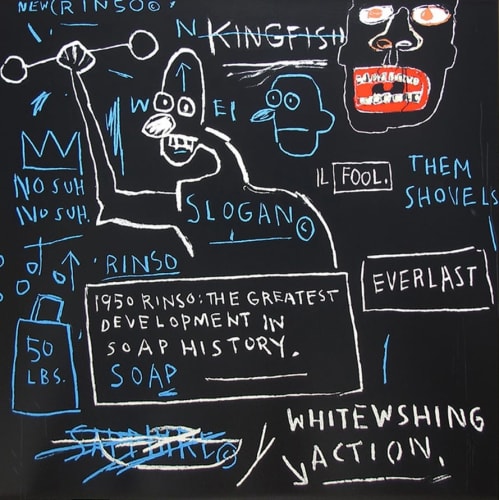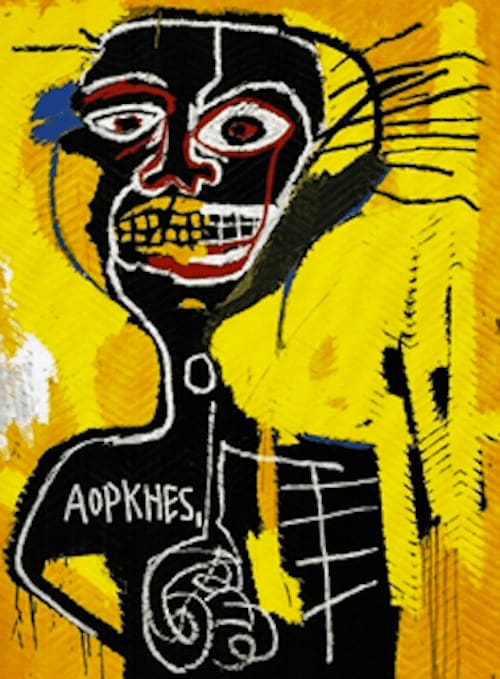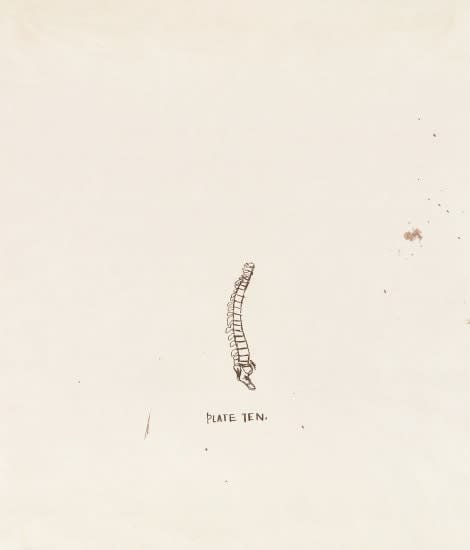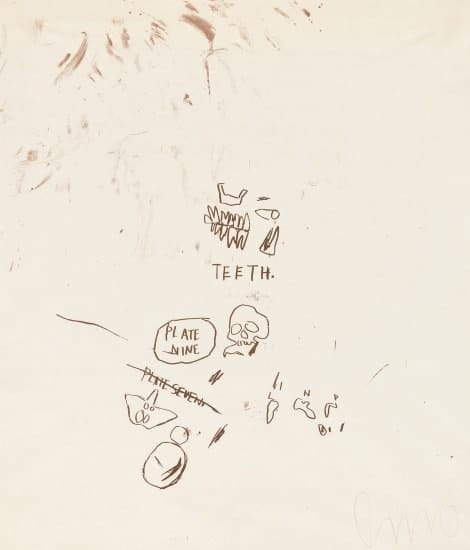In the first half of 2024, the auction market witnessed sustained enthusiasm for the works of Jean-Michel Basquiat, highlighting his enduring influence and appeal. The data reveals a range of sale results that reflect both the diversity and the depth of his artistic output. Notably, works such as Untitled (from Leonardo) and Cabeza, from Portfolio II fetched substantial sums, significantly exceeding their pre-sale estimates. This article offers an analytical review of BASQUIAT'S top-selling works during this period, exploring the specific pieces and their reception in the art market, while providing insights into the trends and valuation dynamics observed at major auctions.

Riddle Me This, A Panel of Experts, Piano
Lesson, Flash In Naples
sold by SBI Art Auction Co
price realised: $265,883
March 9, 2024
Jean-Michel Basquiat's Superhero Portfolio is a vibrant collection that showcases his ability to merge superhero motifs with complex social and personal narratives. The portfolio includes notable works such as Riddle Me This, A Panel of Experts, Piano Lesson, and Flash In Naples, each contributing uniquely to the thematic and stylistic diversity of BASQUIAT'S oeuvre.
Riddle Me This is emblematic of BASQUIAT'S later, more intricate style, reinterpreting the superhero Batman as a symbol of black heroism. This piece is chaotic, adorned with BASQUIAT'S iconic symbols and cryptic texts, blending pop culture with socio-political commentary. Conversely, A Panel of Experts vividly portrays drama and raw emotion, reflecting the tumult of Basquiat's personal life. It features a chaotic depiction of a nightclub brawl involving his girlfriend, using thick black paint to create a sense of depth and concealment, highlighting themes of exposure and privacy.
Piano Lesson and Flash In Naples further illustrate BASQUIAT'S engagement with cultural and historical themes. While specific details about Piano Lesson are less documented, it likely explores African-American cultural themes, possibly against a backdrop of music, a recurring motif in BASQUIAT'S work. Flash In Naples, part of a series of screenprints, possibly juxtaposes the historical richness of Naples with BASQUIAT'S commentary on sudden fame and societal issues. The work embodies his characteristic energy, using layered texts and images to create a dynamic visual experience.
Together, these works underscore BASQUIAT'S unique narrative style and his critical perspective on power, identity, and justice, encapsulated through the lens of heroes.

Untitled (From Leonardo)
sold by Phillips New York
price realised: $177,800
April 16, 2024
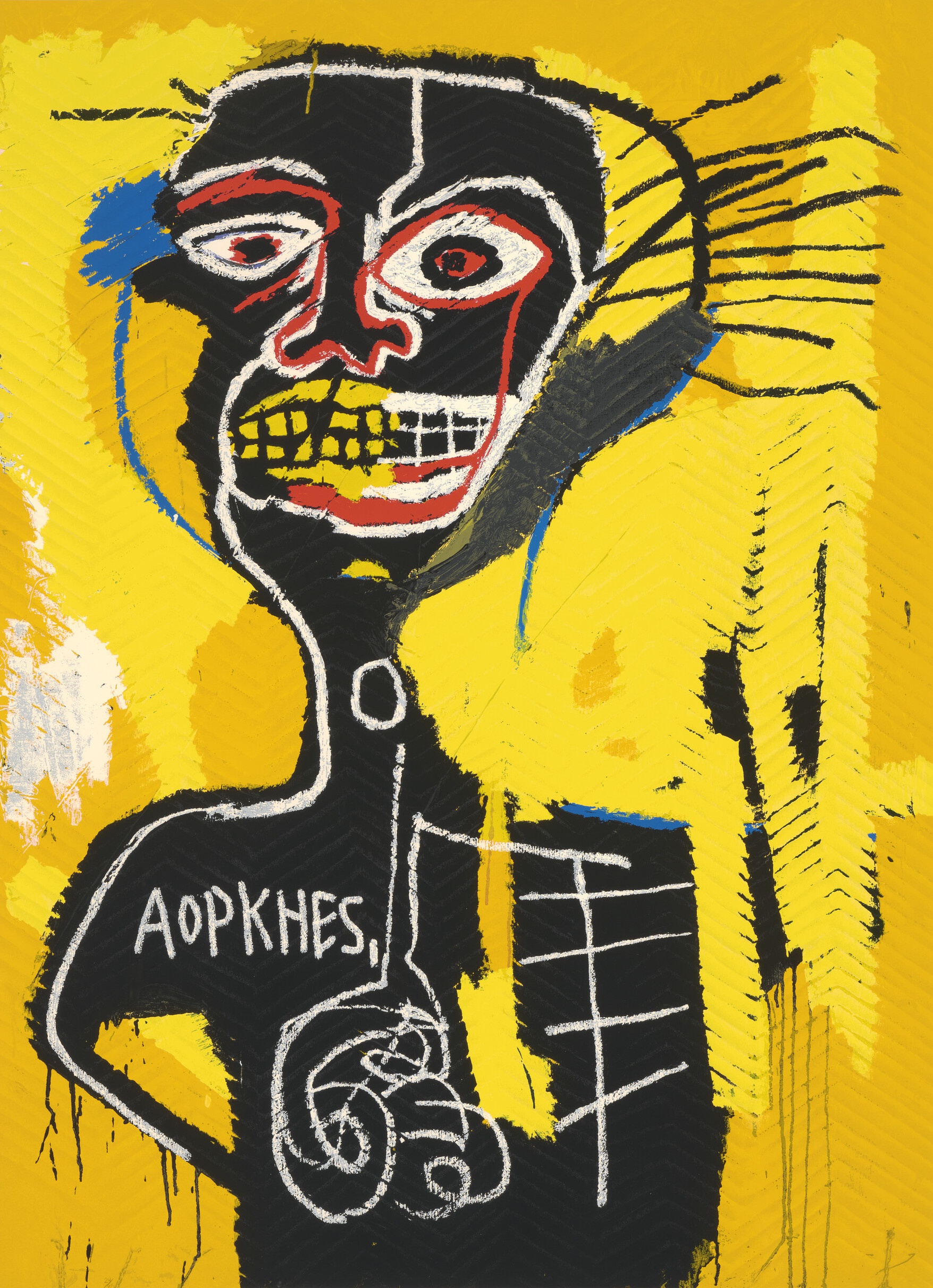
Cabeza, from Portfolio II
sold by Phillips London
price realised: $113,639
June 6, 2024
Jean-Michel Basquiat's Cabeza from Portfolio II is a compelling exploration of themes central to his artistic narrative, including identity, perception, and memory. The title Cabeza, Spanish for head, hints at the recurring motif of skulls and heads that permeate BASQUIAT'S work, symbolizing not only mortality and intellect but also the enduring impact of cultural heritage. This piece likely features a head or skull, rendered in BASQUIAT'S distinctively raw and expressive style, which serves as a potent vessel for commentary.
In Cabeza, BASQUIAT critiques how societies remember and honor their historical and contemporary figures, probing the narratives we construct around individuals and questioning the authenticity and completeness of these recollections. The work employs a vibrant composition, integrating text and symbolic imagery like crowns—perhaps suggesting the nobility or burden of historical figures. Through the use of screenprinting combined with painting techniques, Basquiat adds layers of meaning, the artwork resonating with a sense of immediacy and complexity.
Cabeza encapsulates BASQUIAT'S ability to navigate complex themes through visually striking and thought-provoking imagery. This piece not only reflects on the human condition and societal memory but also showcases BASQUIAT'S unique talent in conveying deep narratives through his art, making it a significant work within his Portfolio II.

Charles the First, from Portfolio II
sold by Christie's New York
price realised: $107,100
March 14, 2024
Jean-Michel BASQUIAT'S Charles The First is a rich tribute to jazz musician Charlie Parker, a key figure in the bebop movement and a profound influence on BASQUIAT'S own engagement with music. In this work, BASQUIAT elevates Parker to a regal status, using crowns and other symbols of greatness to adorn the image, thereby placing the musician within a narrative of nobility and royalty.
The artwork cleverly interweaves allusions to both real and fictional heroes, such as the Norse god Thor, whose name appears beneath a crown, and Superman, hinted at through the recurrent 'S' symbols across the image. This conflation not only highlights Parker’s legendary status in music but also aligns him with King Charles I, drawing a parallel between the musician's legacy and royal lineage. BASQUIAT'S use of these elements underscores a recurring theme in his work: the insertion of Black icons into traditionally white historical narratives.
Further enriching the piece is a poignant inscription at the bottom left: “most young kings get their head cut off.” This phrase alludes to the tragic fates of both King Charles I, who was executed at 24, and Charlie Parker, who passed away at 34. The inclusion of Parker’s daughter Pree’s name in the central panel of the triptych adds a personal touch, weaving Parker’s familial ties into this multifaceted homage. Through Charles The First, BASQUIAT not only celebrates Parker’s musical genius but also comments on the broader historical and cultural impacts of his and other Black figures' legacies.

Flexible
sold by Phillips New York
price realised: $82,550
April 16, 2024
Jean-Michel Basquiat's Flexible, created in 1984 during his time in Venice, California, is an evocative portrayal of the griot, a central figure in West African culture known as a storyteller, entertainer, and keeper of oral history. This piece is a profound exploration of the artist's own role as a modern-day griot, navigating the spheres of history, culture, and personal identity through his art. BASQUIAT employs the griot motif to delve into broader themes concerning the transmission of Black heritage and the enduring impact of ancestral voices in contemporary society.
In Flexible, BASQUIAT'S characteristic use of bold, aggressive brushstrokes and stark, flat areas of color serves a dual purpose. These elements not only introduce depth and texture but also play a crucial role in revealing and concealing the underlying layers of paint and imagery, mirroring the complex layering of history and memory. The artwork incorporates an x-ray view of internal organs, adding a physical and visceral dimension to the depiction of the griot, suggesting a deeper look into the core of identity and existence.
This piece stands out as one of BASQUIAT'S most iconic works, showcasing his unique ability to blend historical and contemporary influences. Through Flexible, BASQUIAT not only highlights his affinity for figures from Black history and earlier cultures but also reflects on his personal struggles and experiences as an artist-as-everyman, making a powerful statement on the role of the artist in society.
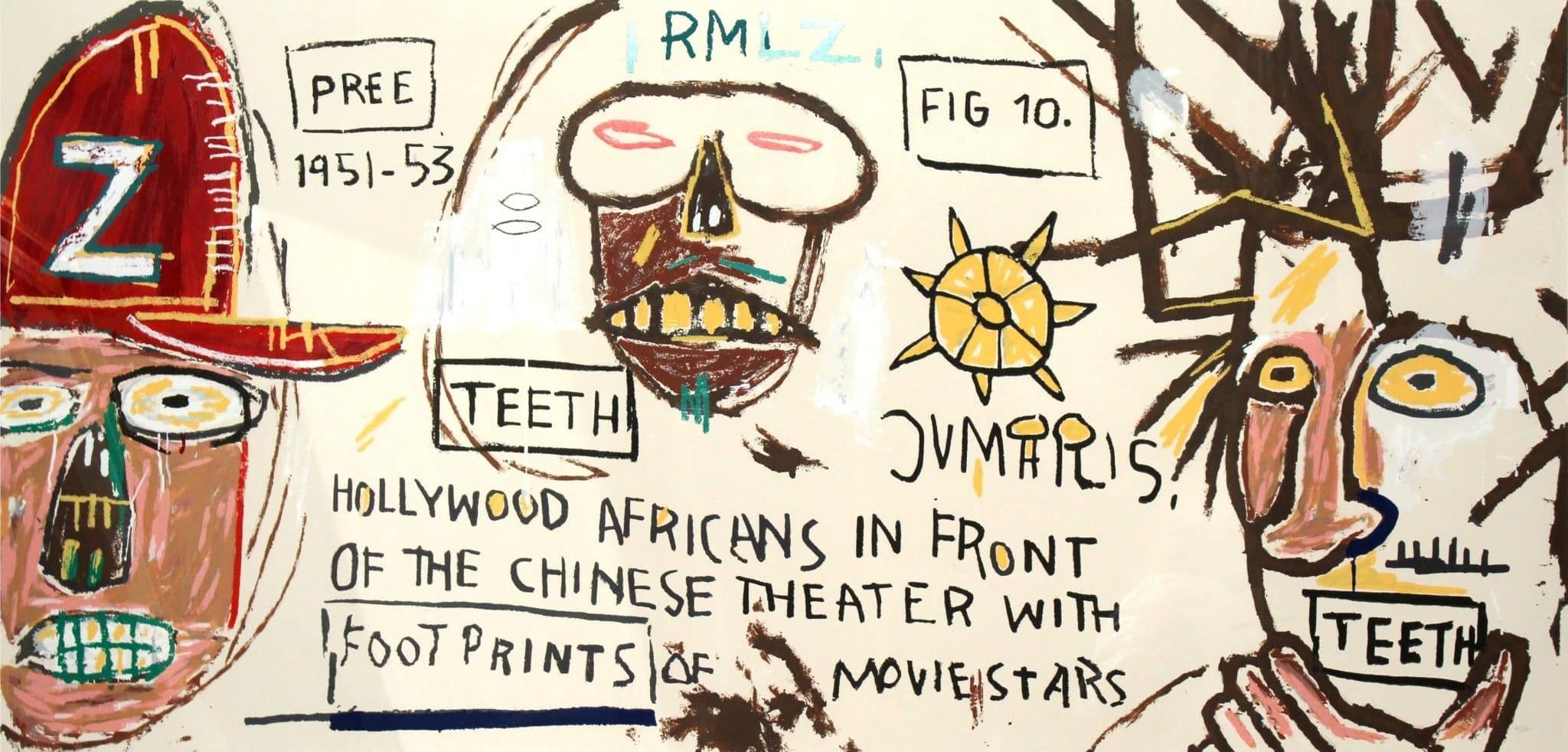
Hollywood Africans in front of the Chinese Theatre with Footprints of Movie Stars
sold by Christie's New York
price realised: $81,900
April 16, 2024
Jean-Michel Basquiat's Hollywood Africans in front of the Chinese Theatre with Footprints of Movie Stars stands as a poignant reflection of his deep-seated concerns regarding racial disparities in America. Created during a time when BASQUIAT was increasingly aware of the dangers posed by societal racism, this artwork manifests his fears and critiques through a socially and politically charged lens. His use of symbolism and the exploration of intrinsic societal dichotomies—wealth versus poverty, integration versus segregation—underscore the thematic depth of his work.
This piece is an extension of the well-known 1983 artwork Hollywood Africans, housed at the Whitney Museum of American Art, which features BASQUIAT and his fellow artists Toxic and Rammellzee. In this depiction, Toxic is positioned on the left, Rammellzee occupies the center (identified by the green letters 'RMLZ' above his figure), and BASQUIAT'S is on the right, recognizable by his characteristic hairstyle. Hollywood Africans comments sharply on the stereotyping and marginalization of African Americans in the entertainment industry—a theme so pertinent that it echoes the controversies surrounding racial equality in Hollywood, as highlighted in recent Oscars ceremonies.
In Hollywood Africans in front of the Chinese Theatre with Footprints of Movie Stars, BASQUIAT challenges traditional artistic norms by blending academic and 'primitive' styles through his distinctive neo-expressionist approach. He makes innovative stylistic choices, such as representing teeth with the word "TEETH" drawn in a way that visually mimics a set of teeth, and employs his signature calligraphy, robust gestures, and vivid colors. This artwork is not only a significant biographical and historical account of BASQUIAT'S life but also continues to resonate with ongoing issues of racial inequality in the entertainment industry and beyond.
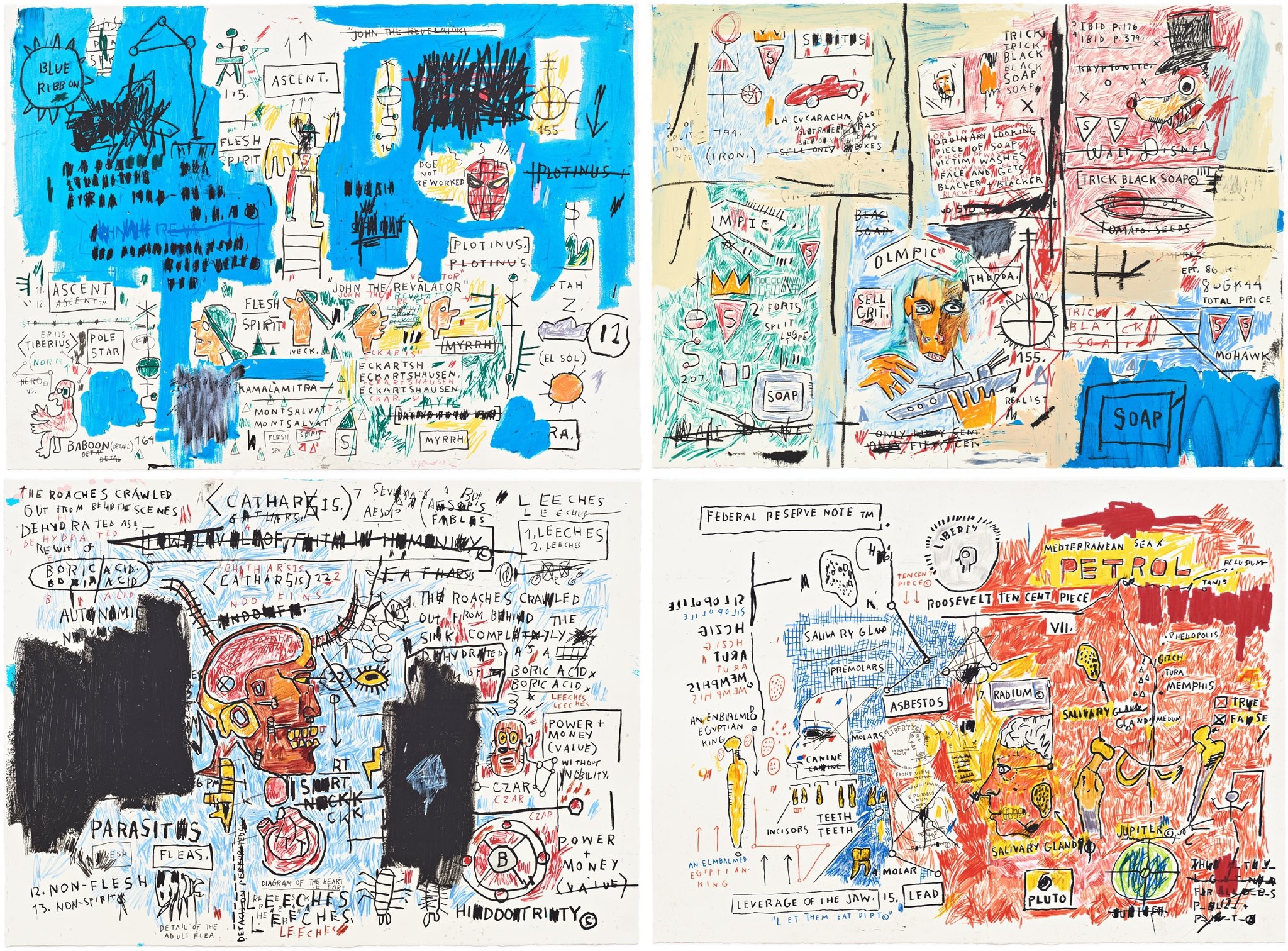
Ascent; Olympic; Leeches; and Liberty
sold by Phillips London
price realied: $68,183
June 6, 2024
BASQUIAT'S print Ascent investigates themes of upward movement or advancement, interpreted both literally and metaphorically. The title itself suggests an exploration of personal or collective achievement, potentially critiquing or celebrating notions of success within American society or against the backdrop of African-American historical struggles. BASQUIAT'S characteristic fusion of text and imagery may here evoke a narrative of rising—socially, personally, or spiritually.
Olympic can be viewed through the lens of competition and excellence, set on the international stage of the Olympic Games, possibly contrasting these ideals with political, racial, and economic conflicts. BASQUIAT'S work often explores dichotomies such as wealth versus poverty and integration versus segregation. This print could reflect on how sports can unite and divide, symbolizing broader societal challenges and triumphs.
Leeches delves into themes of exploitation and parasitism, critiquing how individuals, cultures, or societies exploit others for personal or collective gain. Employing leeches as a metaphor, BASQUIAT might integrate text and iconic imagery to comment on economic, cultural, or political exploitation. His work frequently addresses power dynamics and inequalities, making Leeches a potentially incisive commentary on these issues.
Lastly, Liberty examines the concept of freedom, questioning the authenticity of liberty in a society marked by racial, economic, and social disparities. BASQUIAT's acute historical and justice-oriented perspectives could lead him to critique the American ideal of liberty, highlighting contradictions experienced by marginalized groups. This print could reinterpret iconic symbols such as the Statue of Liberty to expose the complexities and challenges within the narrative of American freedom.
BASQUIAT'S art remains a layered and complex dialogue, where dense symbols and texts invite multiple interpretations. His reflections on identity, race, and societal structures make each artwork a revealing glimpse into his experiences and viewpoints.
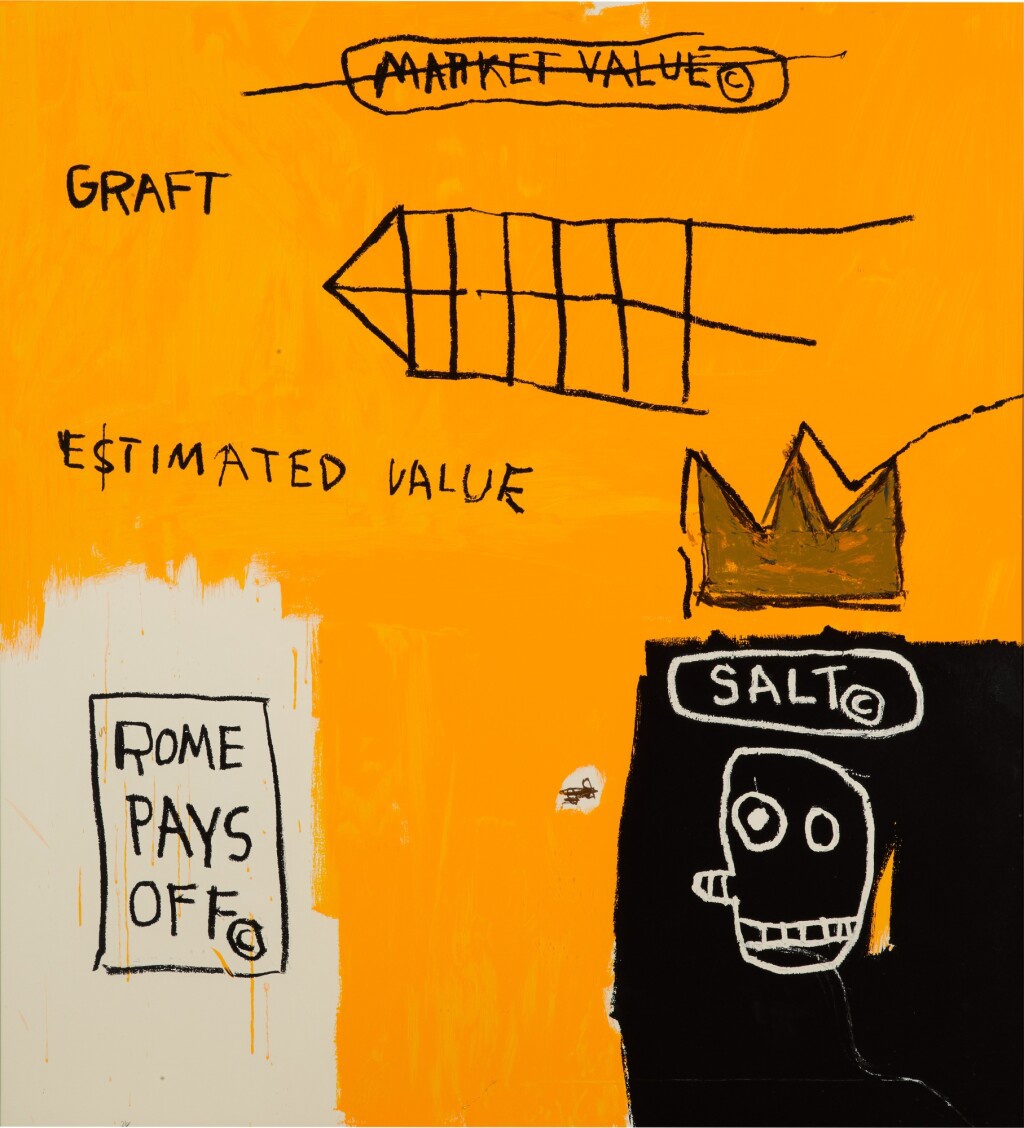
Rome Pays Off, from Portfolio II
SOLD BY PHILLIPS LONDON
price realised $ 68,183
June 6, 2024
Jean-Michel Basquiat's Rome Pays Off is a striking yet sparse composition that features a skeletal face adjacent to a gold crown, accompanied by a grid-like form that resembles both a rocket and an upturned edifice, rendered in stark black. This piece resonates with themes of decline and transformation, invoking the imagery of fallen empires and the explosive potential of modern advancements. The title Rome Pays Off, framed by a copyright sign, directly alludes to BASQUIAT'S earlier graffiti work under the moniker SAMO with Al Diaz. Their work, scrawled across the walls of New York City, served as a pointed critique of a society they viewed as hollow and overly materialistic.
Leonhard Emmerling has remarked on SAMO's graffiti as a counter to societal norms, describing it as a response to the commodification of values and ideals within a rigidly conformist society. In Rome Pays Off, BASQUIAT continues this critique by weaving historical and economic themes into the artwork. The inclusion of references to salt—a commodity of immense value to colonial powers, often referred to as 'white gold'—underscores the lasting impacts of empire and capitalism. These elements suggest a complex dialogue about the costs of economic and political conquests, both historical and contemporary.
The composition and thematic layering in Rome Pays Off reflect BASQUIAT'S unique ability to distill complex socio-political histories into visually compelling artwork. Through the use of skeletal imagery, regal symbolism, and references to economic history, BASQUIAT critiques the enduring influence of imperial and capitalist values on modern society. This piece stands out as an emblematic expression of BASQUIAT'S ongoing engagement with issues of power, legacy, and resistance.
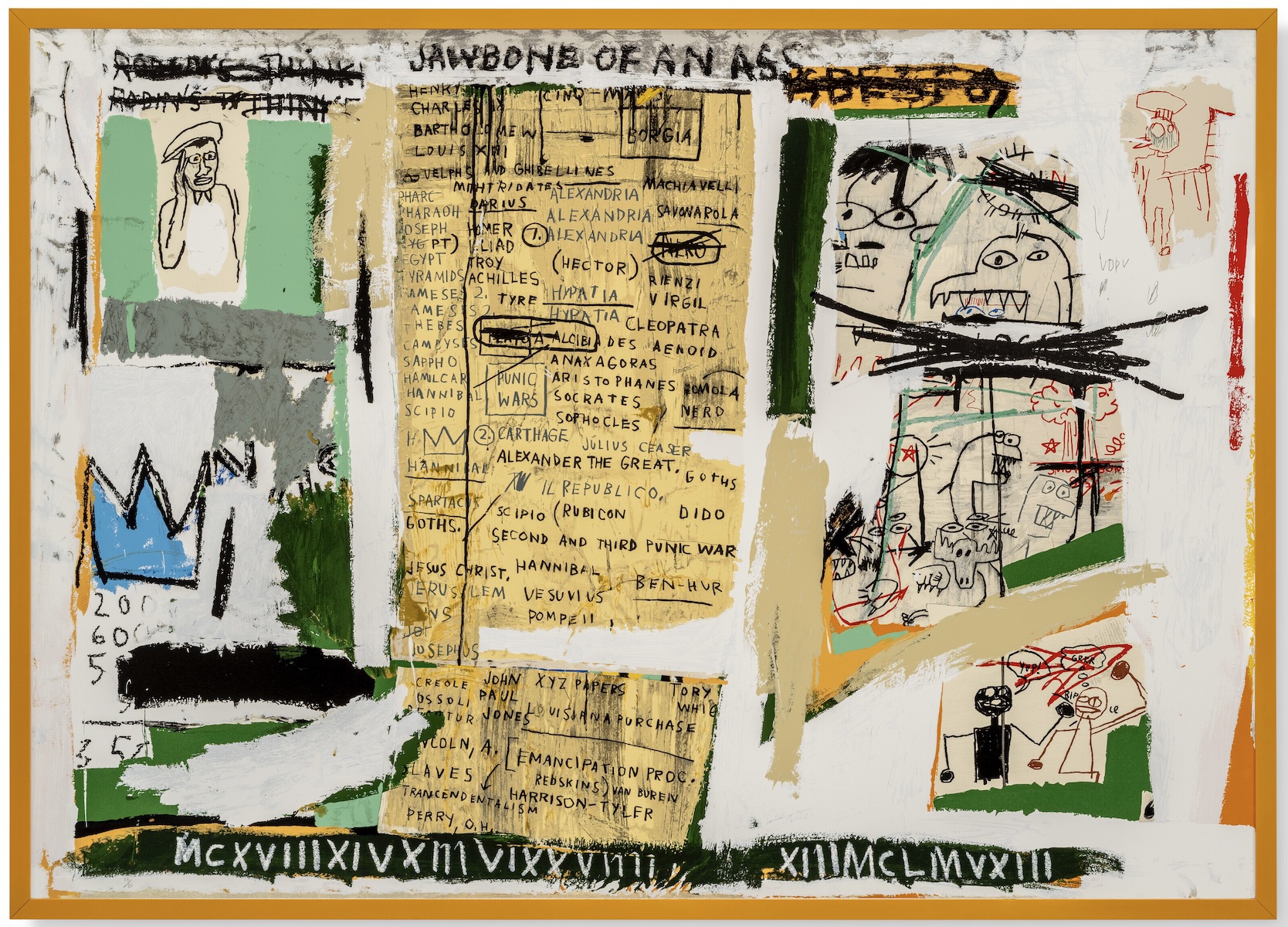
Jawbone of an Ass, from Portfolio II
SOLD BY Christie's New York
PRICE REALISED $ 50,400
March 14, 2024
Few of Jean-Michel BASQUIAT'S works encapsulate his vast cultural knowledge as vividly as Jawbone Of An Ass. The title itself is a direct nod to a biblical verse where Samson proclaims, “With the jawbone of a donkey, heaps upon heaps, with the jawbone of a donkey I have slain a thousand men!” This title not only underscores Basquiat's fascination with the human form but also his penchant for intertwining scriptural references with anatomical exploration.
In Jawbone Of An Ass, BASQUIAT interweaves icons of antiquity such as Cleopatra, Scipio, Hannibal, and Hamilcar with ancient cities like Carthage and Pompeii, creating a rich tapestry of historical narratives. The incorporation of Roman numerals at the base of the image further anchors the work in classical antiquity. The composition invites viewers to piece together BASQUIAT'S dense array of references into a unified interpretation. The artwork is characterized by playful word manipulations where terms are repeated, altered, and juxtaposed—such as Socrates and Sophocles—forming a complex lexical puzzle.
The piece portrays a cyclical view of history fraught with inevitable conflict and catastrophe, as evidenced by references to the Punic Wars, described as “the longest and most severely contested war in history.” This cycle of destruction is not confined to antiquity; it extends to significant American historical events like the Louisiana Purchase and the Emancipation Proclamation, suggesting a recurring theme of upheaval and transformation.
BASQUIAT'S iconic crown motif recurs throughout, interspersed among depictions of stars, explosions, and battling figures, adding layers of meaning with each symbol either obscured by paint or partially crossed out. Notably, just beneath the title, the term ‘sbestos’ is faintly discernible, hinting at an alternative reading as ‘Jawbone of an asbestos.’ This play on words links the biblical weapon to asbestos, critiquing it as a modern instrument of corporate harm and greed, thereby enriching the artwork's critique of power and exploitation across ages.

Boxer Rebellion
SOLD BY SBI Art Auction Co.
PRICE REALISED $ 46,559
January 28, 2024
Jean-Michel Basquiat's 1982 screen print, Boxer Rebellion, vividly captures his admiration for Black boxing icons such as Sugar Ray Robinson, whose influence permeates this dynamic artwork. In the center of the image, two boxers are depicted not with detailed anatomy but in a cartoon-like style, assembled from what appears to be robotic parts. This stylization lends the figures a heroic and futuristic aura, emphasizing their strength and resilience.
The artwork is marked by an explosion of color—vibrant reds, yellows, and blues radiate from the point of impact where one boxer lands a punch on the other, enhancing the visual impact of the confrontation. This use of color and form exemplifies BASQUIAT'S unique approach to portraiture, which often blends a childlike simplicity with complex symbolism.
BASQUIAT'S style in Boxer Rebellion is notably influenced by a variety of popular visual media. The figures’ doodle-like rendering aligns with BASQUIAT'S penchant for childlike drawing styles, which he often combined with elements drawn from anatomic charts and comic books. The inclusion of the word "TECHNICOLOR" within the artwork underscores this influence, pointing to the vibrant, exaggerated style typical of 20th-century comic strips and television. As noted by art historian Leonhard Emmerling, BASQUIAT'S art did not shy away from showcasing its diverse inspirations, which ranged from medical textbooks like Gray’s Anatomy to mainstream comic books and television programs.
Boxer Rebellion stands out as a testament to BASQUIAT'S ability to draw from a wide array of sources, synthesizing them into a visually compelling narrative that celebrates cultural figures and challenges conventional representations. The piece is not only a homage to the legends of the boxing world but also a commentary on the portrayal of heroism and vitality within the context of popular culture.
